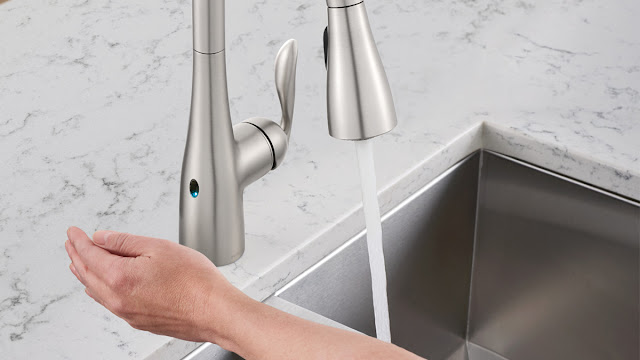Did you know that 20% of your household’s daily water usage comes from the faucets in your house? Surprisingly, it isn’t the big appliances, like the washing machine or the dishwasher, that use the most water. The average U.S. home uses 138 gallons of water from the tap every day. Anything you can do to reduce that water consumption is a drop in the proverbial bucket of water conservation.
Maybe you’ve already replaced your old, water-hog appliances. Hopefully you’ve updated your toilets to the low-flush variety that use less than two gallons of water per flush (instead of 5-7 gallons). If not, it’s a cost-effective change that can save lots of water day-to-day, and money in the long run.
Is there more you can do? Yes! Time to put a dent in that 138 gallons of water coming out of your faucets every day.
Making faucets more water efficient can go a long way to creating a home that’s more environmentally friendly. Here are five simple things you can do.
 Brizo Odin 16 5/8" Kitchen Faucet
Brizo Odin 16 5/8" Kitchen Faucet1. Install Low-Flow Faucets
Low-flow faucets put out less water without sacrificing water pressure. They use just 1.5-2.5 gallons per minute. You can reduce water usage by up to 60% simply by installing low-flow faucets.
There are two basic mechanisms that reduce water output without impacting performance too much: aerators and laminars. They help make faucets more water efficient.
Aerator
An aerator mixes air into the water stream which creates a bunch of tiny water streams flowing together. It maintains the pressure you’re used to without wasting all that water. The water flow has a “soft” feel and doesn’t splash much. The flow coming out of the faucet looks white because of the amount of air mixed into it.
You can replace your faucet with one that has an aerator, or you can add an aerator to your current faucet and get the same result.
Laminar
Laminar faucets produce excellent pressure with less water by forcing the water through larger, but fewer openings. Think of your showerhead and how it has large, individual streams of water—that’s the general idea of the laminar. It does not add air to the flow. Laminar systems produce flow that looks clear (as opposed to the white look of aerated flows) and feels less “soft” to the touch. It can produce a bit more splash because of the lack of incorporated air.
Like an aerator, you can also simply add a laminar to your existing faucet or install a new faucet with the laminar feature built in. You may also want to consider a combination aerator/laminar that helps you boost water efficiency even more. Or go with a multiple laminar, which directs water in a wider pattern to provide better coverage without having to use more water.
2. Try Water Conservation Motion Faucets
One of the best things you can do to save water is to not let the faucet run when you’re not using it. Sounds obvious, but did you turn the faucet off while you brushed your teeth this morning? Did you let the water run while you washed the dishes? Was your shower this morning unnecessarily long? It’s easy to forget how much water can be wasted when we leave the tap on.
One simple way to get rid of this problem is to install water conservation motion sensor faucets. These detect motion and turn on automatically then turn off after a short period of time. You don’t have to worry about turning the faucet off and on while your hands are all soapy. You can zone out while brushing your teeth but never waste water while doing it.
3. Stop Leaks
Leaky plumbing is a water hog. If you have a leak(s), it accounts for at least 13% of your daily water consumption. That’s a whopping 18 gallons a day. Some leaks are obvious. Drippy faucets are easily repaired or replaced with newer, high-efficiency faucets. Other leaks can be more difficult to detect.
For instance, toilet leaks from the tank to the bowl are very hard to detect. Try adding some food coloring to your tank. If there is a leak, the color will start to appear within about 15 minutes. Be sure to flush after your test so you don’t stain the tank.
Leaky plumbing will not only wreak havoc on your water consumption but it can potentially damage cabinets, floors, and more.
4. Buy Products with the WaterSense Label
You’ve seen the “EnergyStar” label that helps you identify products that meet requirements for decreased energy consumption. Have you seen the “WaterSense” label? You’ll find it on products that meet EPA requirements for water efficiency. They use at least 20% less water than regular models.
With only about 1% of the Earth’s water available for human consumption, shortages are a real concern. WaterSense aims to promote a national “ethic of water efficiency” so that waste water can be reduced and the water supply can be protected for future generations.
5. Use Cold Water
Water heating takes a lot of energy. It uses as much (or more) energy as your electronics, lighting, or large appliances. Likewise, it takes a lot of water to make electricity. When you save energy, you save water. Using cold water helps you do this.
Try using cold water for brushing your teeth and washing your clothes. Set your water heater thermostat to a lower temperature. Install a temperature limiter or temperature control faucets. Even if you have your water heater set higher, you can control temperature on faucets where hot water isn’t necessary.
Do something good. Take the first step toward water conservation by making faucets more water efficient. Every drop of water saved makes a difference.








